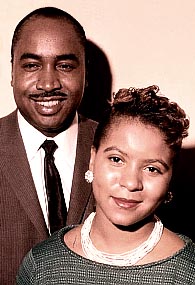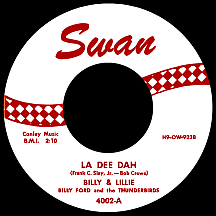BILLY AND LILLIE
La Dee Dah
Bloomfield, New Jersey-born trumpeter-singer Billy Ford entered the music business around 1942 while still a teenager, performing with fellow trumpet man Cootie Williams' band between its early '40s period as The Rug Cutters and Williams' hitmaking peak with vocalist Eddie Vinson that began in 1945. Ford was determined to forge a career as the leader of his own band, anxious to do business much like Cootie did with singing, humorous interludes and a full musical backbeat. Once he got going, nightclub work was always available for Ford's dynamic outfits, but it took a solid decade-and-a-half before he found the right female singer, and a novel approach, that led to nationwide recognition.
In 1951 Billy recorded "Pretty Eyed Baby" for Regal Records, a swinging duet with Joan Shaw, a singer from Newport News, Viginia who four years earlier had been featured with Buddy Tate's band, then with premier sax man Paul Williams, supplying the vocal for his summer '49 hit "He Knows How to Hucklebuck" on Savoy (the follow-up to Paul's long-running, R&B chart-topping instrumental "The Huckebuck"). A second single by Joan and Billy (this one on the Abbey label) came near the end of the year; "Lonesome For My Baby" had a more sultry feel than the previous disc. The following year, the band backed Mr. Sad Head (a.k.a. William "Sunny" Thurman) on his lively RCA Victor singles "Butcher Boy" and "Sad Head Blues."
By 1953 he was calling the group Billy Ford and his Night Riders; two singles appeared on United, "Smooth Rocking" and "Old Age," both rollicking tracks with Billy as the sole vocalist. Instrumental "A String of Pearls" backed with vocal track "Stop Lyin' on Me" was issued by Josie Records in 1955 as Billy Ford and his Combo; the tight five-to-seven-member band featured saxophonist Hugh Brodie and two additional songers: Freddie Pinkard and, for a time, Hickory, North Carolina native Alma Fortez. Shortly after the introduction of Ford Motors' instantly-popular Thunderbird in 1955, Billy changed the name of his group to Billy Ford and the Thunderbirds, getting no flak from the auto manufacturer for what was essentially free promotion for the car.
Ford did the vocals for the band's '55 single on Vik, "How Can I Be Sure" and flip side "Billy Boy" (a hot sax-based take on the traditional tune also known as "Charming Billy"). 17-year-old Lillie Bryant of Newburgh, New York joined around this time, though Ford wasn't immediately sold on the young singer's ability to deliver the slightly more adult fare he was accustomed to. A meeting with Bob Crewe and Frank Slay of XYZ Productions (they'd just hit a home run with "Silhouettes" by The Rays on Philly's recently-established Cameo label) went better than expected. Crewe and Slay, impressed with Lillie's vocal style, got them all together to cut four sides at Allegro Studios (located on the bottom floor of the Brill Building on Broadway in New York). Lillie's two songs included "Good Good Morning, Baby" ('...did my phone call wake you out of your dreams?'), an enticing ballad with Ford and the band singing background. "The Monster" had Freddie Pinkard delivering a growling vocal on a tongue-in-cheek novelty anthem-of-sorts hailing (in a literal Chuck Berry-esque "School Day" way) the impact of the latest trend in music (the monster in question: rock and roll!). But the final song was the deal-sealer, as a ditty by the fresh new vocal duo clicked and took them into the higher reaches of the popularity charts.

The hitmaking team of Billy and Lillie gained attention in early 1958 with "La Dee Dah," a Slay-Crewe concoction using an idea that wasn't exactly new: calling out full or partial titles of recent hits, in this case by Bobby Helms, Ricky Nelson, Thurston Harris, Sam Cooke, Gene Vincent, Andy Williams, Perry Como and the writing team's own Rays ('...you're My Special Angel, my Be-Bop Baby, my Little Bitty Pretty pet, You Send Me with your Lotta Lovin' Lips of Wine, Just Born baby to be my Silhouette!')...cha-cha-cha! Cameo's Bernie Lowe purchased the four recordings in a package deal and then offered what he felt were the weaker efforts ("La Dee Dah" and "The Monster") to Swan Records, a label Bernie Binnick and Tony Mammarella had just started. Guess who got the best end of that business arrangement! Billy and Lillie's unintentional cute-couple approach connected with the public (it didn't hurt that Dick Clark, who had a vested interest in Swan, played "La Dee Dah" frequently during American Bandstand's dance segments). Though Lillie's Cameo disc went nowhere, her collab with Billy hit the top ten in January '58, Swan's first major hit with its second release (the first, "Click-Clack" by Dickey Doo and the Don'ts, also a hit, took a month longer, reaching the top 30 in late February).
A pattern emerged that seemed to position Billy and Lillie as a somewhat more frolicsome counterpart to Mickey and Sylvia. The catchy, contrived lyrics by Crewe and Slay were partly responsible, while the singers had proven very capable of transferring the fun they were having onto vinyl. Mid-charting follow-up "Happiness" used some semi-Latin wordplay ('Olé-o, olé-o, that's why we dance all day-o...marimba, carimba, now let the band begin-a...the mambo, the cha-cha, merenge, cucharacha...') as a hook. Ford's musicians were always at the top of their game and their rhythms skillfully fit the chalypso and other trendy dances of the late '50s. A love story set in "The Greasy Spoon" came off like a low-budget film script, this third single's minor-to major-back to minor key structure revealing a bit of Slay and Crewe's out-of-the-box thinking.
Another major hit emerged as 1959 got under way with "Lucky Ladybug." The brain-twister this time was to try and think of as many good luck charms that could be crammed into 15 seconds ("Ladybug, silver dollar, rabbit's foot...with a four-leaf clover and a horseshoe...wishbone, shamrock's got me shook...singin' abracadabra in a cat's eye...'). Another Lillie Bryant solo 45, "Smoky Gray Eyes (Stroll Smoky)," was set to the popular stroll tempo. Yet none of Billy and Lillie's "side projects" ever became hits. "Bells, Bells, Bells," an unusually fast-paced number for a wedding song, was their final chart single in the summer of '59. Still, they continued working together for years to come.
1960's "That's the Way the Cookie Crumbles" typified the gimmicky nature of those early Bob Crewe-Frank Slay productions. The final Swan release was in '61, then after one effort for Stacy Records ("My Pledge of Love," with an ultra-emotional recitation by Lillie) they signed with ABC-Paramount in '63 and gave producer Clyde Otis a shot. Some alterations to B&L's sound came into play on "Whip it to Me Baby," "Carry Me 'Cross The Threshold" and especially "Why I Love Billy (Why I Love Lillie)," which bore a strong resemblance to Otis's work with Brook Benton and Damita Jo the same year. There was "Tic Tac Toe" on Ric Records and their bluesiest tune certainly had to be the one they did for the Crossroad label, "Baby Don't You Know." A return to Cameo in 1966 resulted in "Nothing Moves (Without a Push)" and "You Got Me By the Heart," each reminiscent of their '50s hits. Through the coming years Billy Ford kept the band going, welcoming Lillie back for occasional performances. He passed away in the early 1980s. Lillie Bryant became active in politics and much later, at an age at which many would have retired, ran for mayor of Newburgh, where she had grown up.


